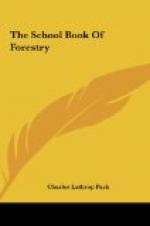CHAPTER XVIII
WOOD FOR THE NATION
Westward the course of forest discovery and depletion has taken its way in the United States. The pine and hardwood forests of the Atlantic and New England States first fell before the bite of the woodman’s ax and the sweep of his saw. Wasteful lumbering finally sapped the resources of these productive timberlands. Shift was then made farther westward to the Lake States. Their vast stretches of white pine and native hardwoods were cut to a skeleton of their original size. The lumbering operations then spread to the southern pine belt. In a few years the supplies of marketable lumber in that region were considerably reduced. Then the westward trail was resumed. The strip of country between the Mississippi River and the Cascade, Sierra Nevada and Coast Ranges was combed and cut. Today, the last big drive against our timber assets is being waged in the forests of the Pacific Coast.
Our virgin forests originally covered 822,000,000 acres. Today, only one-sixth of them are left. All the forest land now in the United States including culled, burned and cut-over tracts, totals 463,000,000 acres. We now have more waste and cut-over lands in this country than the combined forest area of Germany, Belgium, Denmark, Holland, France, Switzerland, Spain and Portugal. The merchantable timber left in the United States is estimated at 2,215,000,000,000 board feet. The rest is second-growth trees of poor quality. One-half of this timber is in California, Washington and Oregon. It is a long and costly haul from these Pacific Coast forests to the eastern markets. Less than one-fifth of our remaining timber is hardwood. 56,000,000,000 board feet of material of saw timber size are used or destroyed in the United States each year. Altogether, we use more than 26,000,000,000 cubic feet of timber of all classes annually. Our forests are making annual growth at the rate of less than one-fourth of this total consumption. We are rapidly cutting away the last of our virgin forests. We also are cutting small-sized and thrifty trees much more rapidly than we can replace them.
[Illustration: A forest crop on its way to the market]
The United States is short on timber today because our fathers and forefathers abused our forests. If they had planted trees on the lands after the virgin timber was removed, we should now be one of the richest countries in the world in forest resources. Instead, they left barren stretches and desolate wastes where dense woods once stood. It is time that the present owners of the land begin the reclamation of our 326,000,000 acres of cut-over timberlands. Some of these lands still are yielding fair crops of timber due to natural restocking and proper care. Most of them are indifferent producers. One-quarter of all this land is bare of forest growth. It is our duty as citizens of the United States to aid as we may in the reforestation of this area.




